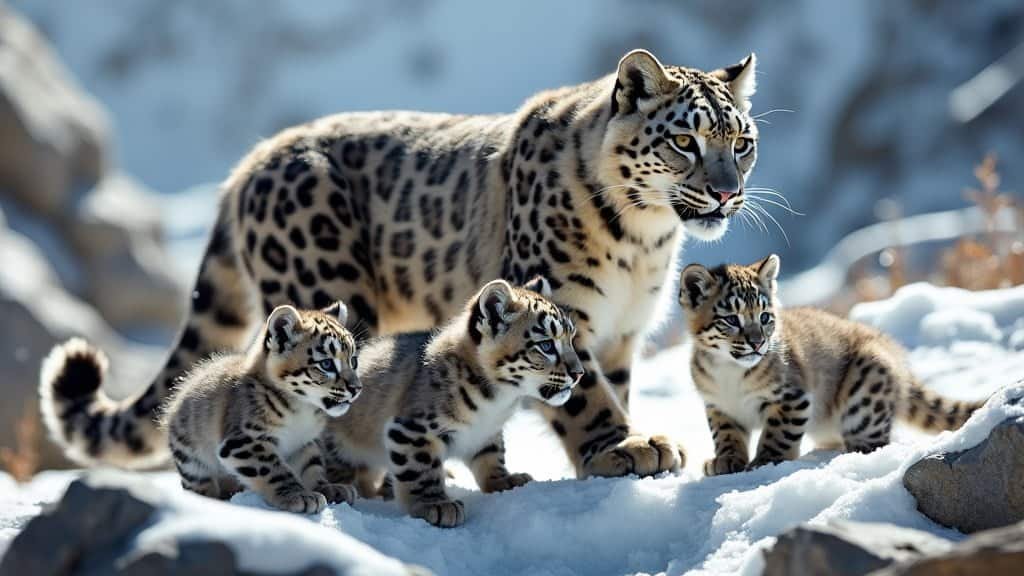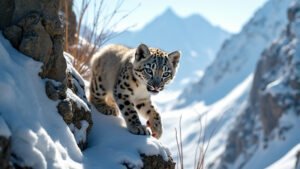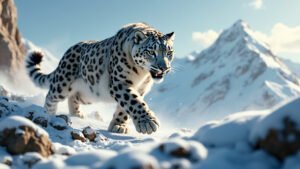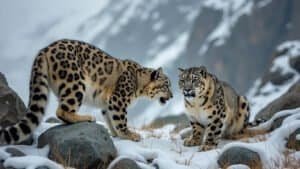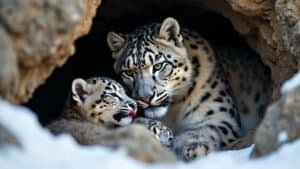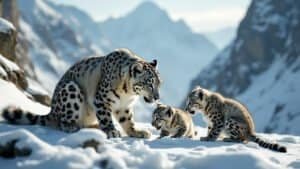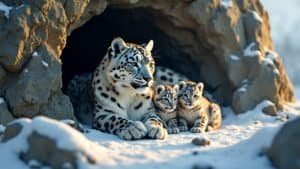Introduction
Snow leopard cubs undergo significant changes during their first year, transitioning from vulnerable newborns to more independent young leopards
In this article, we explore their key development stages, dietary shifts, and the crucial role of the mother in their growth. We also examine their social behaviors, physical transformations, and the challenges they face in their natural habitat
Understanding these factors helps us appreciate the incredible journey of snow leopard cubs as they adapt to their environment and prepare for survival
Key Development Stages of Snow Leopard Cubs
Snow leopard cubs experience a series of crucial developmental stages in their first year, which are vital for their survival in the harsh mountain habitats of Central Asia
From birth to early independence, these stages encompass physical growth, skill acquisition, and social interactions. Understanding these stages provides insight into how these elusive creatures adapt to their environments and prepare for life as solitary hunters
Birth and Early Days
Snow leopard cubs are usually born in remote, well-protected dens high in the mountains. The typical litter size ranges from one to three cubs, with two being the most common
At birth, cubs are blind, deaf, and weigh about 1 to 1.3 pounds (0.5 to 0.6 kg). Their fur is soft, thick, and already spotted, providing camouflage that is essential for their survival. During the first week, they rely entirely on their mother for warmth, nutrition, and protection against predators
For the first 10 days, the cubs remain blind and begin to open their eyes between 7 to 10 days old. By the age of two weeks, they are able to hear and start to react to their surroundings. The mother snow leopard will rarely leave the den during this period, only venturing out to hunt for food
Weaning and Learning to Walk
By the time they are about one month old, snow leopard cubs begin to take their first shaky steps outside the den
During this time, they start developing muscle strength and coordination needed for climbing and navigating their rugged environment. The cubs are highly dependent on their mother, who provides them with milk and introduces them to solid food
Weaning typically begins at around two to three months of age. Cubs start consuming small amounts of meat provided by their mother, who brings back prey to the den
According to research by the Snow Leopard Trust, cubs remain with their mother at the den site for up to three months before starting to explore further away, gaining critical skills such as climbing rocky terrain and stalking prey
Introduction to Solid Food and Hunting Skills
Around the age of four to six months, cubs begin to accompany their mother on hunting trips, where they learn essential survival skills
Hunting lessons involve stealth, stalking, and timing—all crucial for catching prey such as blue sheep, ibex, and other mountain-dwelling herbivores. Cubs learn to observe their mother’s techniques closely, mimicking her movements to develop their own hunting strategies
By six months, snow leopard cubs’ hunting skills start to improve, but they are still dependent on their mother for food. The period between six to twelve months is crucial for honing their hunting skills
Cubs learn to make kills, though they may not be successful hunters until they are closer to one year old. This phase marks the transition from dependence to developing the independence needed to survive on their own in the wild
Dietary Changes in the First Year
Snow leopard cubs undergo significant dietary changes in their first year, transitioning from their mother’s milk to a carnivorous diet of meat
This transition is essential for their growth and development as apex predators in the mountainous regions they inhabit. Understanding these changes gives insight into how cubs adapt to their environment and prepare for independent life
Nursing Period and Transition to Solid Food
For the first two to three months, snow leopard cubs are entirely dependent on their mother’s milk
This period is critical for building their immune system and providing the necessary nutrients for initial growth. The mother’s milk contains antibodies that help protect the cubs from diseases and infections in the early stages of life
Around the third month, the cubs start to transition from exclusive nursing to consuming solid food. The mother begins bringing small pieces of meat from her kills back to the den. This phase is vital for introducing the cubs to the taste and texture of their future diet
The gradual introduction of solid food helps their digestive systems adjust to processing meat. By this time, cubs have developed the necessary teeth to chew small chunks of meat
Hunting Practices and Prey Selection
Between four and six months of age, the cubs’ diet primarily consists of meat from the prey their mother hunts, such as blue sheep (bharal), ibex, and smaller mammals like marmots. Snow leopards are obligate carnivores, meaning their diet must be meat-based for survival
During this period, cubs observe and learn from their mother’s hunting techniques. This learning phase is crucial, as successful hunting skills are vital for their survival in adulthood
The selection of prey is often determined by availability and the hunting expertise of the mother. Cubs learn to adapt their hunting techniques to the challenging, steep terrain of their habitat
According to a study published by the Wildlife Conservation Society in 2021, snow leopard cubs practice these skills under the mother’s supervision until they are about 10 to 12 months old. They start making their own attempts at hunting smaller animals, although their success rate remains low at first
Nutritional Needs and Growth Requirements
The diet of snow leopard cubs must be rich in protein and fat to support their rapid growth and development. Cubs grow quickly during their first year, with significant weight gain occurring as they transition from milk to meat
By the age of one, a snow leopard cub can weigh anywhere from 50 to 75 pounds, depending on its access to food and overall health. Proper nutrition is critical for developing strong muscles, bones, and a thick, insulating coat that is essential for survival in the cold, high-altitude environments where snow leopards live
As the cubs approach the end of their first year, they become more skilled and confident hunters. By this stage, they are eating primarily solid food and have become less dependent on their mother for sustenance
Their ability to secure food independently marks a significant milestone in their development, preparing them for the challenges of life as solitary adult snow leopards
Role of the Mother in Cubs’ Development
The mother snow leopard plays a pivotal role in the survival and development of her cubs throughout their first year
She is not only the primary source of nourishment but also the teacher and protector, guiding them through essential learning experiences that shape their ability to survive in the wild. Her involvement is crucial from birth until the cubs are ready to fend for themselves
Protection and Nurturing Behaviors
From the moment they are born, snow leopard cubs rely heavily on their mother for protection. She selects well-hidden dens in rugged, rocky terrains that are difficult for predators to access
This provides the cubs with a secure environment where they can grow during their most vulnerable early days. The mother is fiercely protective, guarding the den from potential threats, including predators such as wolves and large birds of prey. She will often go to great lengths to ensure her cubs remain hidden and safe.
The mother also plays a vital nurturing role by providing warmth, cleaning the cubs, and ensuring they stay close
During the first few weeks, she rarely leaves the den, venturing out only to hunt, after which she quickly returns to her cubs. Her presence during these formative weeks helps regulate the cubs’ body temperature and reduces stress, which is crucial for their early development
Teaching Hunting and Survival Techniques
As the cubs grow, the mother begins to introduce them to the basics of hunting and survival
This process starts around four to six months of age when the cubs start accompanying her on hunting trips. Here, they learn crucial survival skills such as stalking prey, judging distances, and recognizing opportunities and dangers in their mountainous environment
According to a study by McCarthy et al. (2017) published in Biological Conservation, snow leopard cubs learn to mimic their mother’s stealth and patience, which are key components of successful hunting strategies
These lessons are not just about hunting but also about survival. Cubs learn how to navigate their rugged habitat, which includes climbing steep rock faces and leaping across vast chasms. They are taught how to find shelter, avoid dangers, and, importantly, how to conserve energy in the sparse, prey-scarce environments typical of snow leopard habitats
Preparing Cubs for Independence
The ultimate goal of the mother snow leopard is to prepare her cubs for independence. This preparation involves gradually reducing the amount of care she provides, encouraging the cubs to rely on their developing skills
As they approach one year of age, the cubs start to spend more time away from their mother, testing their abilities to hunt and navigate on their own. This gradual detachment process helps the cubs build confidence and resilience
By the time they are about 18 to 22 months old, snow leopard cubs typically become fully independent. They are ready to leave their mother and establish their own territory, which can be a challenging process given the limited availability of suitable habitats and competition from other snow leopards
Nevertheless, the foundation laid by the mother during the first year is crucial for their survival in the wild. Cubs that have successfully learned from their mother’s teachings are better equipped to handle the challenges of finding food, avoiding predators, and eventually reproducing
Social Behavior and Independence of Snow Leopard Cubs
Snow leopard cubs, while typically solitary as adults, exhibit complex social behaviors during their first year that are crucial for their survival and development
These behaviors help cubs learn essential life skills, build physical strength, and prepare for eventual independence. Observing the social dynamics of snow leopard cubs reveals how they transition from dependent young to self-sufficient predators
Interaction with Siblings and Play Behavior
Cubs from the same litter engage in frequent play, which is a critical aspect of their social development. This play behavior includes wrestling, chasing, and mock hunting, which serve multiple purposes
Firstly, play helps develop the physical coordination, strength, and agility needed for hunting and navigating their rugged terrain. Secondly, it allows cubs to practice essential hunting tactics like stalking, pouncing, and pinning—skills they will need to survive on their own
The social interactions among siblings also help establish hierarchies within the litter. Dominance games can determine which cubs are more assertive or submissive, which may influence their behavior as adults
According to a study in Animal Behaviour (Smith et al., 2020), such interactions are important for social learning, where cubs develop crucial skills for both cooperation and competition
Developing Territory Awareness
As cubs grow older, they begin to explore areas farther from the den. This exploration phase usually starts around six months of age and is essential for developing spatial awareness and learning about their potential future territories
Cubs learn to recognize the scents and markings of other snow leopards, which is crucial for avoiding conflicts and establishing their own territories as adults
Snow leopards are known for their large home ranges, which can span up to 80 square miles or more. The process of territory exploration under the guidance of the mother teaches the cubs to navigate vast areas, identify potential prey locations, and understand the boundaries of other predators
This knowledge becomes critical as they prepare to leave their mother and establish their own territory, a process that requires finding a balance between abundant prey availability and minimal competition
When Do Cubs Leave Their Mother?
The journey to independence for snow leopard cubs is a gradual one. By the time they are around 18 to 22 months old, cubs typically begin to leave their mother’s side permanently
The timing of this separation can vary based on environmental factors, prey availability, and the individual cub’s development. Cubs must have honed their hunting skills, understood territorial boundaries, and built the necessary strength and resilience to survive on their own
Upon leaving their mother, cubs must establish their own territory, which can be a perilous process. Younger snow leopards often face the challenge of securing territory without encroaching on the ranges of established adults, who can be highly territorial
This period is critical, as young snow leopards face increased risks from other predators, starvation, and environmental challenges. Successful independence relies heavily on the foundation laid during their first year with their mother and siblings
Overall, the transition to independence involves a combination of learning, practice, and instinct honed over the cubs’ first year. Cubs that successfully navigate this phase are well-prepared for the solitary life of a snow leopard, capable of thriving in some of the harshest environments on Earth
Physical and Behavioral Changes During the First Year
Throughout their first year, snow leopard cubs undergo significant physical and behavioral changes that are essential for their survival
These changes include growth milestones, adaptations to their harsh environments, and shifts in behavior that prepare them for independence. Understanding these transformations provides a deeper insight into how snow leopards adapt and thrive in the rugged terrains of Central Asia
Growth Milestones and Physical Adaptations
From birth to one year, snow leopard cubs experience rapid growth, developing from small, vulnerable newborns into agile and powerful young leopards. At birth, cubs weigh about 1 to 1.3 pounds (0.5 to 0.6 kg) and are blind and helpless
However, by the end of their first month, they start opening their eyes, and their weight begins to increase significantly as they nurse and gain strength
By three to four months of age, their motor skills improve, and they start developing the muscular build needed to navigate their mountainous habitats. Snow leopard cubs grow rapidly during this phase, reaching weights between 25 to 35 pounds
Their limbs and paws become stronger, allowing them to climb rocks and traverse steep terrains. These physical adaptations are crucial for hunting and survival in the rocky environments they call home
By the time they are a year old, snow leopard cubs weigh between 50 to 75 pounds and have developed thick, dense fur to protect them from the cold. Their long tails, which help with balance and warmth, are fully grown. This physical transformation from a helpless cub to a robust predator is essential for facing the challenges of the wild
Changes in Fur and Markings
One of the most distinctive features of snow leopards is their beautiful, spotted coat, which evolves significantly during the cubs’ first year. At birth, snow leopard cubs have soft, dense fur with lighter spots
As they mature, their fur becomes thicker and denser to provide insulation against the cold temperatures of their high-altitude habitats, which can drop to -40°F (-40°C) or lower in winter
By six months, the cubs’ markings become more defined, with the dark rosettes and spots on their coat becoming more prominent. These markings not only provide effective camouflage against the rocky, snowy landscapes but also play a role in communication and identification among snow leopards
The development of their distinctive coat pattern is a key adaptation that helps them remain undetected by both prey and predators in their mountainous environments
Behavioral Shifts Toward Independence
Behavioral changes in snow leopard cubs during their first year are closely tied to their physical development. In the early months, cubs are highly dependent on their mother, staying close to her for warmth, nourishment, and protection
However, as they grow stronger and more mobile, their behavior begins to shift toward increased exploration and independence
Around six months of age, cubs begin to show curiosity about their surroundings, often venturing out of the den to explore nearby areas. This curiosity is crucial for learning about their environment, including identifying potential prey, water sources, and safe resting spots
By nine months, their play behaviors start incorporating more realistic hunting practices, such as stalking and pouncing, which help develop their skills and instincts
By the end of their first year, snow leopard cubs exhibit a higher degree of independence. They are more confident in navigating their environment, are better hunters, and have developed the social behaviors needed to interact with other snow leopards
These behavioral shifts, combined with their physical growth and adaptations, mark their readiness to eventually leave their mother and survive independently in the wild
Conclusion
The first year of a snow leopard cub’s life is marked by a series of critical developmental stages that are essential for their survival and eventual independence
From birth to becoming self-sufficient young predators, cubs undergo significant physical, behavioral, and social changes. These include crucial growth milestones, learning essential hunting and survival skills from their mother, and adapting to their cold, rugged environments
The mother snow leopard plays a vital role in this journey, providing protection, nourishment, and guidance. Cubs learn to navigate their complex habitats, develop strong social bonds with their siblings, and gradually shift toward independence as they hone their hunting skills
By understanding the development of snow leopard cubs in their first year, we gain a deeper appreciation of the challenges these elusive animals face and the remarkable adaptations that enable them to thrive in some of the world’s most remote and harsh terrains
